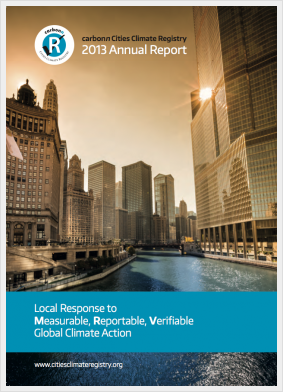
New report reveals transparency is key to close city climate finance gap
10 June 2014
by Richard Forster
Four hundred and twenty-two local and subnational governments are improving their credit worthiness in their climate actions, according to the carbonn Cities Climate Registry (cCCR) 2013 Annual Report released today at the ongoing UN Bonn Climate Change conference in Bonn, Germany.
“Trustworthiness, good governance and transparency are key to credit worthiness,” said Gino Van Begin, Secretary General of ICLEI-Local Governments for Sustainability. “By voluntarily reporting to the cCCR, cities and regions not only create momentum for accelerating local climate action, they also demonstrate trustworthiness, accountability, and eligibility for receiving the much needed funds for climate mitigation and adaptation actions.”
The cCCR catalyses the trustworthiness of local and subnational governments by improving transparency, accountability and comparability of local climate actions. The cCCR is the world’s largest public database of local climate action covering 442 cities from 44 countries serving 12 percent of the world’s urban population. It contains 3,870 mitigation and adaptation actions, 870 climate and energy commitments, and 771 inventories covering around 2.25 gigatonnes Co2e of annual greenhouse gas emissions.
ICLEI, the worldwide association of more than 1,000 cities working on sustainability, operates the cCCR. Trustworthiness is a key step in ensuring that local and subnational governments can finance local climate actions that could bring down global green house gas emissions and build resilience against climate change. An estimated US$200 to US$210 billion per annum in 2030 is required to finance mitigation actions worldwide. Billions more are needed to fund adaptation actions. According to the cCCR data, local and subnational governments have reported about US$145 billion worth of climate investments. Fifty-seven percent of these investments have been driven by local governments themselves. A funding gap of approximately US$341 million still needs to be filled to finance the 188 climate mitigation and adaptation actions on the cCCR.
“Global transparency builds trust in local and subnational governments and facilitates their access to finance and engagement of citizens,” added Van Begin.
This figure is expected to rise as local and subnational governments gain more responsibility in the global efforts on climate change. Worldwide, funding for climate actions is increasing with major financial institutions such as the Asian Development Bank, the Inter-American Development Bank, the European Investment Bank, the Global Environment Facility, the Global Energy Basel launching financial assistance programmes specifically for local and subnational governments.
Eligibility requirements are however still rigid, costly, and time consuming. According to the World Bank estimates, only a small percentage of the 500 largest cities in developing countries are deemed creditworthy–about 4 percent in international financial markets and 20 percent in local markets. Further capacity development on this topic is currently being explored. Lima, Peru, the host of the upcoming UN Climate Conference, is one of the few developing cities that has already achieved a credit-worthy status. Lima is a pioneer reporting city of the cCCR and has reported a total of six completed climate actions.










